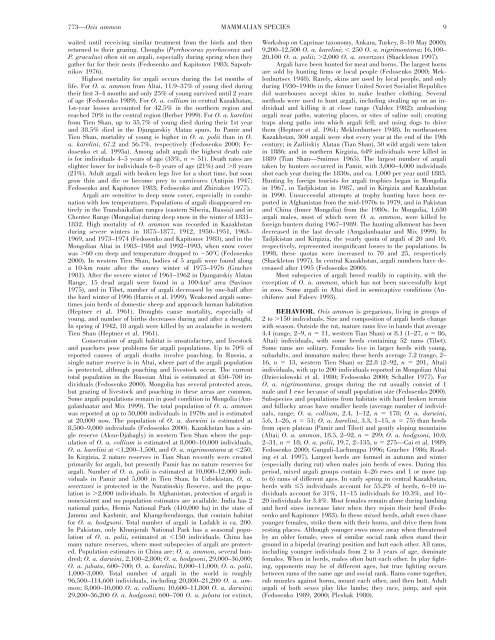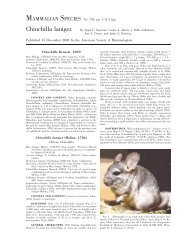You also want an ePaper? Increase the reach of your titles
YUMPU automatically turns print PDFs into web optimized ePapers that Google loves.
773—<strong>Ovis</strong> <strong>ammon</strong><br />
MAMMALIAN SPECIES 9<br />
waited until receiving similar treatment from the birds and then<br />
returned to their grazing. Choughs (Pyrrhocorax pyrrhocorax and<br />
P. graculus) often sit on argali, especially during spring when they<br />
gather fur for their nests (Fedosenko and Kapitonov 1983; Sapozhnikov<br />
1976).<br />
Highest mortality for argali occurs during the 1st months of<br />
life. For O. a. <strong>ammon</strong> from Altai, 11.9–37% of young died during<br />
their first 3–4 months and only 25% of young survived until 2 years<br />
of age (Fedosenko 1989). For O. a. collium in central Kazakhstan,<br />
1st-year losses accounted for 42.5% in the northern region and<br />
reached 70% in the central region (Berber 1999). For O. a. karelini<br />
from Tien Shan, up to 35.7% of young died during their 1st year<br />
and 38.5% died in the Djungarskiy Alatau spurs. In Pamir and<br />
Tien Shan, mortality of young is higher in O. a. polii than in O.<br />
a. karelini, 67.2 and 56.7%, respectively (Fedosenko 2000; Fedosenko<br />
et al. 1995a). Among adult argali the highest death rate<br />
is for individuals 4–5 years of age (33%, n 51). Death rates are<br />
slighter lower for individuals 6–8 years of age (21%) and 8 years<br />
(21%). Adult argali with broken legs live for a short time, but soon<br />
grow thin and die or become prey to carnivores (Antipin 1947;<br />
Fedosenko and Kapitonov 1983; Fedosenko and Zhiriakov 1977).<br />
Argali are sensitive to deep snow cover, especially in combination<br />
with low temperatures. Populations of argali disappeared entirely<br />
in the Transbaikalian ranges (eastern Siberia, Russia) and in<br />
Chentee Range (Mongolia) during deep snow in the winter of 1831–<br />
1832. High mortality of O. <strong>ammon</strong> was recorded in Kazakhstan<br />
during severe winters in 1875–1877, 1912, 1950–1951, 1963–<br />
1969, and 1973–1974 (Fedosenko and Kapitonov 1983), and in the<br />
Mongolian Altai in 1983–1984 and 1992–1993, when snow cover<br />
was 60 cm deep and temperature dropped to 50C (Fedosenko<br />
2000). In western Tien Shan, bodies of 5 argali were found along<br />
a 10-km route after the snowy winter of 1975–1976 (Grachev<br />
1981). After the severe winter of 1961–1962 in Djungarskiy Alatau<br />
Range, 15 dead argali were found in a 100-km 2 area (Savinov<br />
1975), and in Tibet, number of argali decreased by one-half after<br />
the hard winter of 1996 (Harris et al. 1999). Weakened argali sometimes<br />
join herds of domestic sheep and approach human habitation<br />
(Heptner et al. 1961). Droughts cause mortality, especially of<br />
young, and number of births decreases during and after a drought.<br />
In spring of 1942, 18 argali were killed by an avalanche in western<br />
Tien Shan (Heptner et al. 1961).<br />
Conservation of argali habitat is unsatisfactory, and livestock<br />
and poachers pose problems for argali populations. Up to 70% of<br />
reported causes of argali deaths involve poaching. In Russia, a<br />
single nature reserve is in Altai, where part of the argali population<br />
is protected, although poaching and livestock occur. The current<br />
total population in the Russian Altai is estimated at 450–700 individuals<br />
(Fedosenko 2000). Mongolia has several protected areas,<br />
but grazing of livestock and poaching in these areas are common.<br />
Some argali populations remain in good condition in Mongolia (Amgalanbaatar<br />
and Mix 1999). The total population of O. a. <strong>ammon</strong><br />
was reported at up to 50,000 individuals in 1970s and is estimated<br />
at 20,000 now. The population of O. a. darwini is estimated at<br />
8,500–9,000 individuals (Fedosenko 2000). Kazakhstan has a single<br />
reserve (Aksu-Djabagly) in western Tien Shan where the population<br />
of O. a. collium is estimated at 8,000–10,000 individuals,<br />
O. a. karelini at 1,200–1,500, and O. a. nigrimontana at 250.<br />
In Kirgizia, 2 nature reserves in Tian Shan recently were created<br />
primarily for argali, but presently Pamir has no nature reserves for<br />
argali. Number of O. a. polii is estimated at 10,000–12,000 individuals<br />
in Pamir and 5,000 in Tien Shan. In Uzbekistan, O. a.<br />
severtzovi is protected in the Nuratinskiy Reserve, and the population<br />
is 2,000 individuals. In Afghanistan, protection of argali is<br />
nonexistent and no population estimates are available. India has 2<br />
national parks, Hemis National Park (410,000 ha) in the state of<br />
Jammu and Kashmir, and Khangchendzonga, that contain habitat<br />
for O. a. hodgsoni. Total number of argali in Ladakh is ca. 200.<br />
In Pakistan, only Khunjerab National Park has a seasonal population<br />
of O. a. polii, estimated at 150 individuals. China has<br />
many nature reserves, where most subspecies of argali are protected.<br />
Population estimates in China are: O. a. <strong>ammon</strong>, several hundred;<br />
O. a. darwini, 2,100–2,800; O. a. hodgsoni, 29,000–36,000;<br />
O. a. jubata, 600–700; O. a. karelini, 8,000–11,000; O. a. polii,<br />
1,000–3,000. Total number of argali in the world is roughly<br />
96,500–114,600 individuals, including 20,800–21,200 O. a. <strong>ammon</strong>;<br />
8,000–10,000 O. a. collium; 10,600–11,800 O. a. darwini;<br />
29,200–36,200 O. a. hodgsoni; 600–700 O. a. jubata (or extinct,<br />
Workshop on Caprinae taxonomy, Ankara, Turkey, 8–10 May 2000);<br />
9,200–12,500 O. a. karelini; 250 O. a. nigrimontana; 16,100–<br />
20,100 O. a. polii; 2,000 O. a. severtzovi (Shackleton 1997).<br />
Argali have been hunted for meat and horns. The largest horns<br />
are sold by hunting firms or local people (Fedosenko 2000; Meklenburtsev<br />
1948). Rarely, skins are used by local people, and only<br />
during 1930–1940s in the former United Soviet Socialist Republics<br />
did warehouses accept skins to make leather clothing. Several<br />
methods were used to hunt argali, including stealing up on an individual<br />
and killing it at close range (Valdez 1982); ambushing<br />
argali near paths, watering places, or sites of saline soil; creating<br />
traps along paths into which argali fell; and using dogs to drive<br />
them (Heptner et al. 1961; Meklenburtsev 1948). In northeastern<br />
Kazakhstan, 300 argali were shot every year at the end of the 19th<br />
century; in Zailiiskiy Alatau (Tian Shan), 50 wild argali were taken<br />
in 1886; and in northern Kirgizia, 649 individuals were killed in<br />
1889 (Tian Shan—Smirnov 1965). The largest number of argali<br />
taken by hunters occurred in Pamir, with 3,000–4,000 individuals<br />
shot each year during the 1830s, and ca. 1,000 per year until 1885.<br />
Hunting by foreign tourists for argali trophies began in Mongolia<br />
in 1967, in Tadjikistan in 1987, and in Kirgizia and Kazakhstan<br />
in 1990. Unsuccessful attempts at trophy hunting have been reported<br />
in Afghanistan from the mid-1970s to 1979, and in Pakistan<br />
and China (Inner Mongolia) from the 1980s. In Mongolia, 1,630<br />
argali males, most of which were O. a. <strong>ammon</strong>, were killed by<br />
foreign hunters during 1967–1989. The hunting allotment has been<br />
decreased in the last decade (Amgalanbaatar and Mix 1999). In<br />
Tadjikistan and Kirgizia, the yearly quota of argali of 20 and 10,<br />
respectively, represented insignificant losses to the populations. In<br />
1998, these quotas were increased to 70 and 25, respectively<br />
(Shackleton 1997). In central Kazakhstan, argali numbers have decreased<br />
after 1995 (Fedosenko 2000).<br />
Most subspecies of argali breed readily in captivity, with the<br />
exception of O. a. <strong>ammon</strong>, which has not been successfully kept<br />
in zoos. Some argali in Altai died in semicaptive conditions (Anchiforov<br />
and Faleev 1993).<br />
BEHAVIOR. <strong>Ovis</strong> <strong>ammon</strong> is gregarious, living in groups of<br />
2to150 individuals. Size and composition of argali herds change<br />
with season. Outside the rut, mature rams live in bands that average<br />
4.4 (range, 2–9, n 11, western Tian Shan) or 8.1 (1–27, n 86,<br />
Altai) individuals, with some herds containing 52 rams (Tibet).<br />
Some rams are solitary. Females live in larger herds with young,<br />
subadults, and immature males; these herds average 7.2 (range, 2–<br />
16, n 13, western Tien Shan) or 22.8 (2–92, n 201, Altai)<br />
individuals, with up to 200 individuals reported in Mongolian Altai<br />
(Dzieciolowski et al. 1980; Fedosenko 2000; Schaller 1977). For<br />
O. a. nigrimontana, groups during the rut usually consist of 1<br />
male and 1 ewe because of small population size (Fedosenko 2000).<br />
Subspecies and populations from habitats with hard broken terrain<br />
and hillocky areas have smaller herds (average number of individuals,<br />
range; O. a. collium, 2.4, 1–12, n 178; O. a. darwini,<br />
5.6, 1–26, n 51; O. a. karelini, 3.3, 1–15, n 75) than herds<br />
from open plateau (Pamir and Tibet) and gently sloping mountains<br />
(Altai; O. a. <strong>ammon</strong>, 18.5, 2–92, n 299; O. a. hodgsoni, 10.0,<br />
2–31, n 18; O. a. polii, 19.7, 2–135, n 275—Cai et al. 1989;<br />
Fedosenko 2000; Ganguli-Lachungpa 1996; Grachev 1986; Reading<br />
et al. 1997). Largest herds are formed in autumn and winter<br />
(especially during rut) when males join herds of ewes. During this<br />
period, mixed argali groups contain 4–26 ewes and 1 or more (up<br />
to 6) rams of different ages. In early spring in central Kazakhstan,<br />
herds with 5 individuals account for 55.2% of herds, 6–10 individuals<br />
account for 31%, 11–15 individuals for 10.3%, and 16–<br />
20 individuals for 3.4%. Most females remain alone during lambing<br />
and herd sizes increase later when they rejoin their herd (Fedosenko<br />
and Kapitonov 1983). In these mixed herds, adult ewes chase<br />
younger females, strike them with their horns, and drive them from<br />
resting places. Although younger ewes move away when threatened<br />
by an older female, ewes of similar social rank often stand their<br />
ground in a bipedal (rearing) position and butt each other. All rams,<br />
including younger individuals from 2 to 3 years of age, dominate<br />
females. When in herds, males often butt each other. In play fighting,<br />
opponents may be of different ages, but true fighting occurs<br />
between rams of the same age and social rank. Rams come together,<br />
rub muzzles against horns, mount each other, and then butt. Adult<br />
argali of both sexes play like lambs; they race, jump, and spin<br />
(Fedosenko 1989, 2000; Pleshak 1980).
















